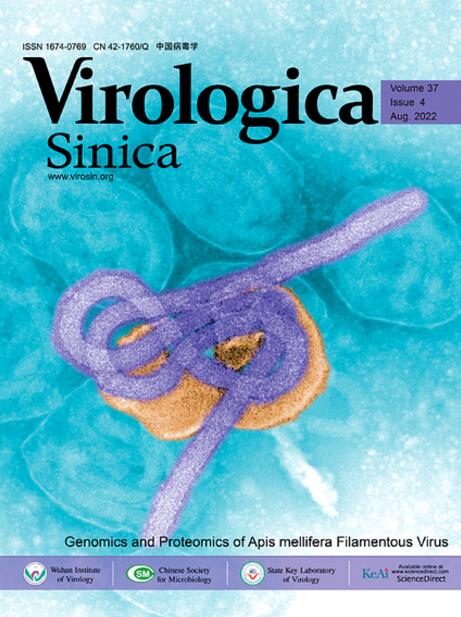发现并鉴定 Ligularia jaluensis 植物中的一种新型黄病毒。
IF 4
3区 医学
Q1 Medicine
引用次数: 0
摘要
獐牙菜是中国重要的药用和观赏植物。然而,能够感染獐牙菜的病毒仍然未知。在此,我们利用RNA-seq分析在表现出萎黄病和黄环斑症状的石蒜植株中鉴定出了一种新型黄化病毒(暂定名为石蒜黄化病毒(LJCV))以及一种已知的鸢尾严重花叶病毒(ISMV)。LJCV基因组由8497 nt正义单链RNA(不包括poly(A)尾)组成,包含6个开放阅读框(ORF)。根据全长基因组和 RNA 依赖性 RNA 聚合酶(RdRp)氨基酸(aa)序列进行的系统进化分析表明,LJCV 与已知的卡莱病毒属病毒同属一个进化分支。LJCV的ORF1编码的RdRp蛋白与8种密切相关的克拉拉病毒的相应蛋白有45.38%-67.41%的相同性。ORFs 2-4 构成了三重基因块(TGB),其中 TGBp1 和 TGBp3 定位于内质网(ER),而 TGBp2 则定位于质膜(PD),并促进病毒在细胞间的移动,其对马铃薯病毒 X 运动缺陷突变体(PVX-Δp25-GFP)的互补能力就证明了这一点。此外,ORF6编码一种富含半胱氨酸的蛋白(CRP),该蛋白定位于叶绿体,是一种病毒致病因子,可在异源PVX表达系统中诱发严重的病毒症状。此外,我们还成功构建了 LJCV 的感染性 cDNA 克隆,并发现它可以通过机械接种或农杆菌介导的 LJCV 感染性克隆浸染烟草植物。这些发现加深了我们对克拉维病毒的特征和宿主范围的了解,也加深了我们对能够感染L.jaluensis的病毒的了解。本文章由计算机程序翻译,如有差异,请以英文原文为准。
Discovery and characterization of a novel carlavirus in Ligularia jaluensis plants
Ligularia jaluensis is an important medicinal and ornamental plant in China. However, the viruses capable of infecting Ligularia jaluensis remains unknown. Here, we identified a novel carlavirus, tentatively named ligularia jaluensis carlavirus (LJCV), as well as a known iris severe mosaic virus (ISMV), in L. jaluensis plants displaying chlorosis and yellow ring spot symptoms, using RNA-seq analysis. The LJCV genome consists of an 8497 nt positive-sense, single-stranded RNA [excluding the poly(A) tail], and contains six open reading frames (ORFs). Phylogenetic analyses based on the full-length genome and RNA-dependent RNA polymerase (RdRp) amino acid (aa) sequences revealed that LJCV clusters within an evolutionary branch alongside known viruses in the Carlavirus genus. The RdRp protein encoded by ORF1 of LJCV shared 45.38%–67.41% identity with the corresponding proteins of eight closely related carlaviruses. ORFs 2–4 constitute the triple gene block (TGB), with TGBp1 and TGBp3 localized in the endoplasmic reticulum (ER), while TGBp2 is localized at plasmodesmata (PD) and facilitates viral intercellular movement, as demonstrated by its ability to complement the potato virus X with movement-deficient mutant (PVX-Δp25-GFP). Additionally, ORF6 encodes a cysteine-rich protein (CRP) that is localized in the chloroplast and functions as a viral pathogenicity factor, inducing severe viral symptoms in the heterologous PVX expression system. Furthermore, we successfully constructed an infectious cDNA clone of LJCV, and found that it can infect Nicotiana benthamiana plants through mechanical inoculation or agrobacterium-mediated infiltration of the LJCV infectious clone. These findings enhance our understanding of the characteristics and host range of carlaviruses, as well as the viruses capable of infecting L. jaluensis.
求助全文
通过发布文献求助,成功后即可免费获取论文全文。
去求助
来源期刊

Virologica Sinica
Biochemistry, Genetics and Molecular Biology-Molecular Medicine
CiteScore
7.70
自引率
1.80%
发文量
3149
期刊介绍:
Virologica Sinica is an international journal which aims at presenting the cutting-edge research on viruses all over the world. The journal publishes peer-reviewed original research articles, reviews, and letters to the editor, to encompass the latest developments in all branches of virology, including research on animal, plant and microbe viruses. The journal welcomes articles on virus discovery and characterization, viral epidemiology, viral pathogenesis, virus-host interaction, vaccine development, antiviral agents and therapies, and virus related bio-techniques. Virologica Sinica, the official journal of Chinese Society for Microbiology, will serve as a platform for the communication and exchange of academic information and ideas in an international context.
Electronic ISSN: 1995-820X; Print ISSN: 1674-0769
 求助内容:
求助内容: 应助结果提醒方式:
应助结果提醒方式:


